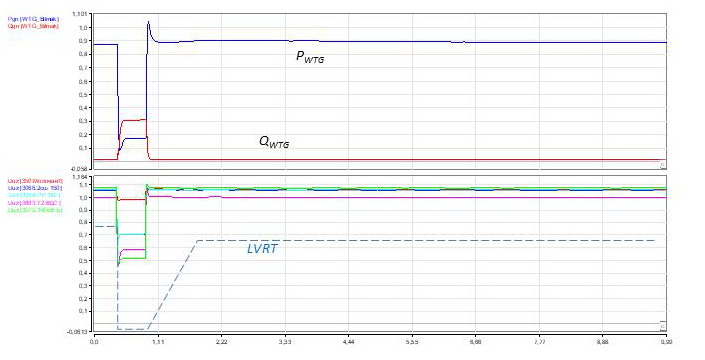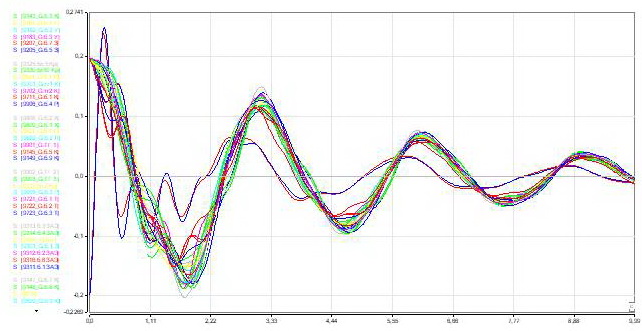The calculation of static and dynamic stability is performed for:
- selection of the basic scheme of the power system and clarification of the location of the main equipment;
- selection of operating modes of power systems;
- selection of measures to improve the sustainability of power systems;
- determine the settings of the regulation and control systems, relay protection (RP), automatic reclosing (AR), etc.;
- determine the settings of PC systems designed to improve the stability of power systems;
- verification of compliance with regulatory sustainability indicators.
IKNET provides services for static and dynamic stability calculations.
Dynamic stability of the power system
Dynamic stability is the ability of a power system to return to a steady state of operation after significant disturbances (short circuit, shutdown of any element of the power system, etc.), in which changes in the mode parameters compared to the values of these parameters without switching to asynchronous mode.
When determining the methods of analysis of dynamic stability, the transmission system operator (TSO) applies the following rules:
- If the limits of static stability are reached before the limits of dynamic stability, the TSO, taking into account emergency situations from the list of emergency situations, should perform a dynamic stability analysis only based on the results of dynamic stability calculations performed for long-term planning.
- If, when planning outages, the limits of dynamic stability are reached earlier than the limits of static stability, TSO taking into account emergency situations from the list of emergency situations should conduct an analysis of dynamic stability at the stage of operational planning one day ahead while these modes exist. The TSO should prepare corrective actions that will be used if necessary during real-time work.
- If the network is in real time in situation "N", and the limits of dynamic stability are reached before the limits of static stability, the TSO, taking into account emergency situations from the list of emergency situations, should analyze dynamic stability at all stages of operational planning and be able to reassess faster limits of dynamic stability after a significant change in mode.
If the dynamic sustainability analysis indicates a violation of the sustainability boundaries, the TSO should develop, prepare and activate corrective actions to maintain the sustainability of the transmission system. These corrective actions may include transmission / distribution system users.
TSO should set up equipment, relay protection and emergency control automation in such a way that, when eliminating violations that can lead to large-scale buckling of the system, is less than the critical damage repair time calculated by him in the analysis of dynamic stability.
The object of the study of dynamic stability is the calculation of the response of the system to a specific set of accidents, usually single-phase or three-phase short-circuits, which can be eliminated by turning off power lines. Generators' reaction is checked to ensure that all equipment operates synchronously, the oscillation damping in the power system remains at an acceptable level, and the voltage recovery after an accident occurs properly.
Simulation of transients should take into account all relevant impacts in the time frame of interest, usually a few seconds after the occurrence of the accident, is subject to the analysis of transients. It is also necessary to accurately reproduce the response of the system given the frequency of the recorded oscillations. Usually, fluctuations in the power system occur in the range from 0.2 to 2 Hz. It is also very important to simulate the ability (or inability) of a station to control voltage in this time frame.
An example of a single-phase short circuit on a 150 kV overhead line with a duration of 500 ms is given below.

Static stability of the power system
Static stability is the ability of a power system to return to a steady state after small mode disturbances, at which changes in parameters are very small compared to their average values.
Static stability margin for steady state operation of power systems is determined by its proximity to the boundary of the stability region. This stock is characterized by safety factors. Under the conditions of static stability of power systems, they normalize the minimum safety factors for active power in the cross sections and the minimum safety factors for voltage at the load nodes. In addition, groups of normative disturbances are established, under which both dynamic stability and normative static stability reserves in post-accident conditions must be ensured.
To determine the safety factor of static stability by the active power in the cross section of the circuit, weighting of the mode is performed by increasing the power flow in the cross section to obtain the maximum stability mode.
During operation, as a rule, the value of active power flows should be used to monitor compliance with statutory static stability margins. If necessary, set as functions of flows in other sections of the maximum permissible and emergency endurable flows. Such flows and voltage should be considered as controlled parameters. Depending on the specific conditions, other parameters of the power system mode can be used as controlled, in particular the values of the angles between the voltage vectors at the ends of the transmission line. The permissible values of the monitored parameters for which the normative safety factor for active power is ensured are established on the basis of calculations of the respective operating modes of the power systems.
To monitor compliance with the standard voltage reserves in operational practice, you can use the voltage in any nodes of the power system. Allowable voltage values in the monitored nodes are determined by calculations of the operating modes of the power systems.
To obtain a complete picture of the static stability of the operating modes of power units of the Interconnected Power System of Ukraine, it is necessary to check the initial normal, repair and post-emergency modes of oscillating stability taking into account the corresponding mathematical models of both the generators and their excitation systems with AEC (automatic excitation control).
Below is shown the slip of the rotors of the generators and the voltages at the output of the AEC of 57 generators of Ukrainian power plants. As can be seen from these dependencies, the initial operation mode of all generators is statically stable.
An example of a single-phase short circuit on a 150 kV overhead line with a duration of 500 ms is given below.

The values of the stability indicators depending on the cross-sectional flow, network diagrams and regulatory disturbances should not be lower than those given in the table.
| Flow in cross section | Minimum safety factor for active power Кр | Minimum safety factor for voltage Кu | Perturbation groups for which stability in cross section is to be ensured | |
| with a normal scheme | with a repair scheme | |||
| Normal | 0,20 | 0,15 | І, ІІ, ІІІ | І, ІІ*, ІІІ** |
| Weighted | 0,20 | 0,15 | І, ІІ | І |
| Forced (post-accident) | 0,08 | 0,10 | - | - |
Note:
*- In addition to single-phase short-circuit fault with circuit breaker failure and the device backup failure switch operation in a 110-220 kV network.
**- only for multi-phase short circuits with successful and unsuccessful automatic reclosing in the 750 kV network.
Calculations of the sustainability of power systems and the estimated verification of measures to ensure it are a mandatory part of the design and operation of power systems.







